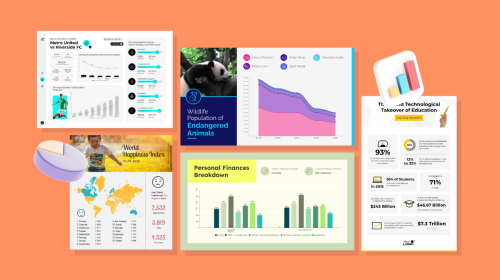
Interactive Marketing: Strategies, Examples & More


Your customers are bombarded with countless marketing messages daily. Traditional marketing methods just don't cut it anymore with all easily distracted customers.
Interactive marketing can help you cut through the noise and truly engage your audience.
With interactive marketing, you’re not just talking at your audience—you’re inviting them to join the conversation.
In this article, we'll dive into the different types of interactive marketing campaigns as well as strategies and real-life examples to inspire you. We’ll also guide you through a step-by-step process of creating your own interactive marketing strategy.
Before you get started, take a look at this video to see how Visme can supercharge your interactive marketing efforts.
Interactive marketing is a customer-centric marketing strategy that emphasizes personalized, two-way communications between a brand and its audience.
It utilizes engaging visuals, videos, games, infographics, blogs, email campaigns, AI-powered chatbots, augmented reality experiences and other elements to engage customers in real time and deliver tailored experiences based on their actions, preferences and feedback.
While both interactive and direct marketing aim to reach customers, they differ significantly in their approach and execution.
Interactive marketing uses a two-way communication approach to drive engagement and deliver personalized customer experiences. This means customers aren’t just receiving marketing messages; they’re actively engaging with them and getting feedback or a response based on their input.
For example, here’s an interactive block on Visme’s data visualization landing page. Users can click on the buttons to reveal a relevant GIF or video for each step.
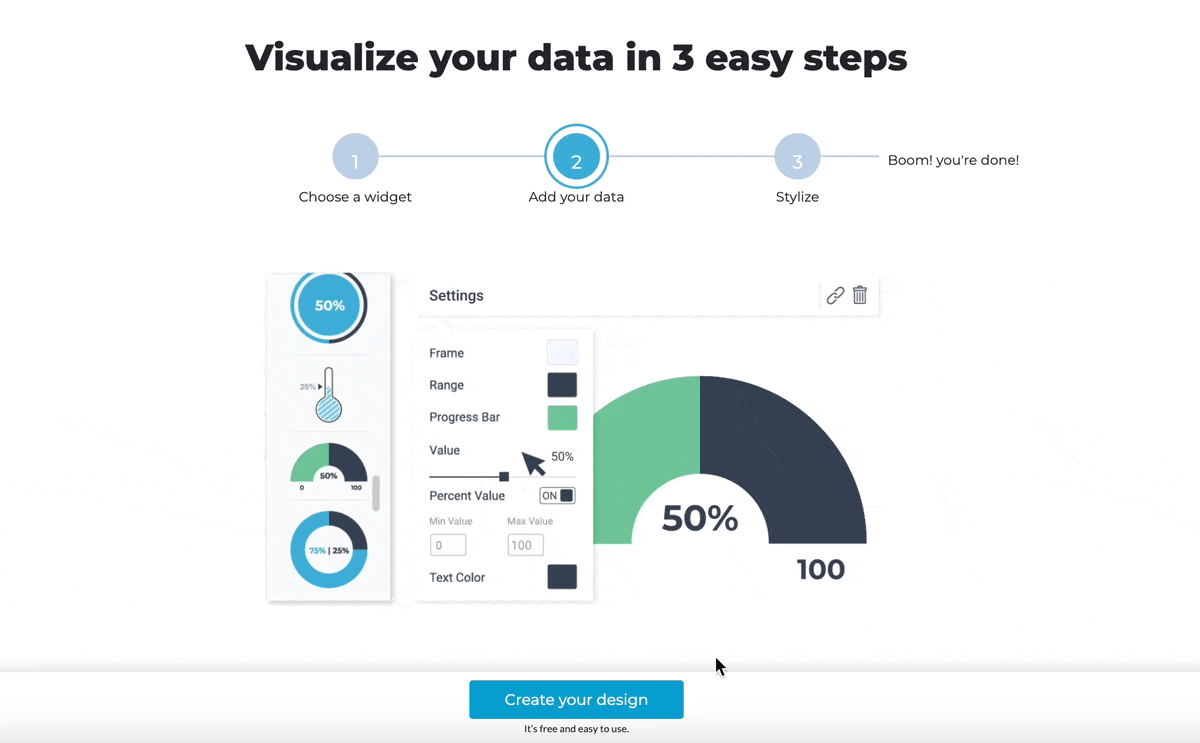
Direct marketing, in contrast, relies on a more traditional, one-way communication model. It focuses on delivering specific messages or offers to the target audience to prompt action without needing them to engage or interact directly with the content.
Some examples of direct marketing channels include static content or landing pages, broadcast advertisements, telemarketing and direct mail. You can also classify non-personalized, mass-marketing emails as direct marketing.
There are several advantages of interactive marketing, but it also comes with its own set of challenges. Understanding these can help marketers make informed decisions about implementing this strategy:
Interactive marketing solutions can take many shapes and forms. Here are several types of interactive marketing strategies brands use to engage their audiences:
This type of content encourages active engagement rather than passive viewing. For example, you can transform static ebooks, reports and blog posts into interactive content by adding elements like links, hover effects, hotspots, videos and GIFs and animation.
Head of Content
Here’s an example of an interactive ebook template from Visme:
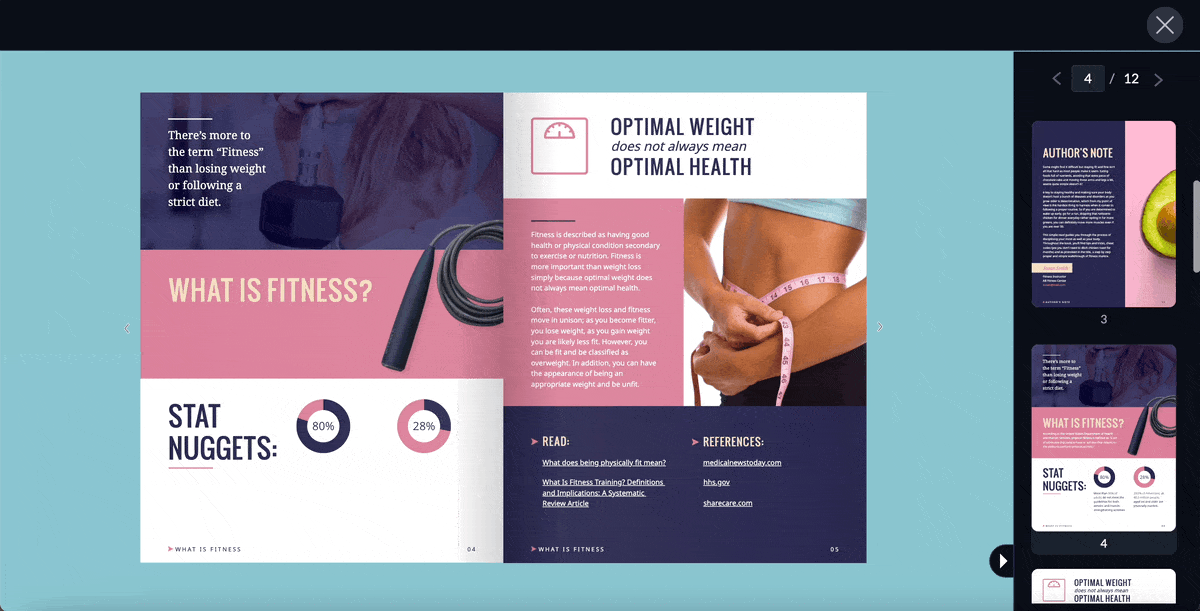
You can also create infographics, charts and maps that users can directly interact with, such as by clicking or hovering on specific areas like stock photos to reveal more information.
Check out this example of a color-coded interactive map from Visme:
Made with Visme Presentation Maker
Tools are functional interactive elements that provide immediate value to users. For example, you can create quizzes, surveys and polls that engage your audience while collecting valuable data like customer needs and preferences.
Visme’s form builder, for instance, lets you create highly engaging and interactive forms to collect user feedback or encourage sign-ups. You can completely customize your form’s appearance and even add animated characters to grab attention and boost conversions.
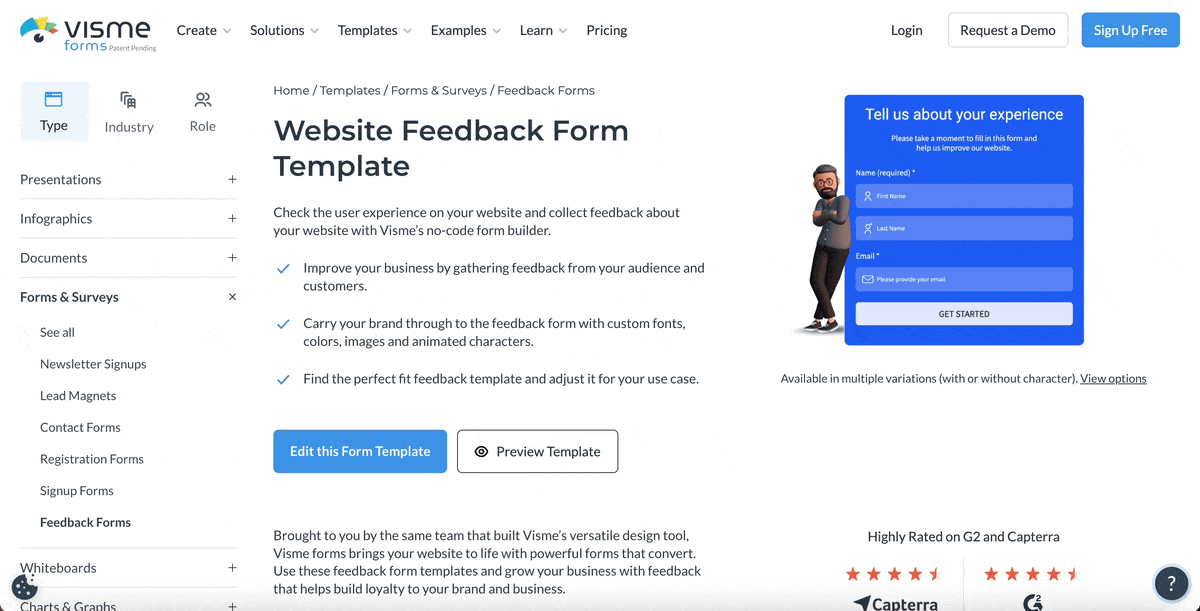
Other types of interactive tools include calculators that help users crunch numbers for personalized insights, graders that assess user inputs to provide tailored feedback and generative AI tools that create unique content based on prompts.
Visme, for example, offers several AI-powered tools like the AI Writer, the AI Image Generator and the AI Designer to help you create custom text, images and editable designs.
We all know video is one of the most engaging content types out there. But is it interactive? It could be. Here are some types of interactive elements you can add to your videos to encourage active participation from watchers:
Live events go even further than interactive video since they’re not pre-recorded and happen in real-time. They provide an opportunity for your brand to collect immediate feedback, address concerns and build connections with your audience by adding a human touch to your marketing activities.
For example, you could host Q&A sessions for direct engagement with your customers. Along with being interactive, Q&A sessions also help build trust by providing transparency into your business’s personality and processes.
Other popular types of live events include webinars and product demos. These are especially used by SaaS companies that want to generate leads and build authority in their niche.

Webinars let you explore high-level topics in detail, combining a presentation style with interactive elements like live chat and polls. Product demos, on the other hand, allow you to showcase your product in action while taking customer questions on the spot.
Social media is not just for one-sided, mindless scrolling. Platforms like Facebook, Instagram, YouTube and Twitter offer plenty of features to help brands interact directly with users.
We asked Chelse, an experienced social media expert to share her go-to strategies for sparking meaningful conversations and building stronger, more engaged communities. Here's what she had to share:
Social Media Strategist and Influencer Manager at Visme
Here are several ways to make your social media campaigns more interactive:
Here’s an example of an Instagram story by Walmart with an interactive “Shop now” button:
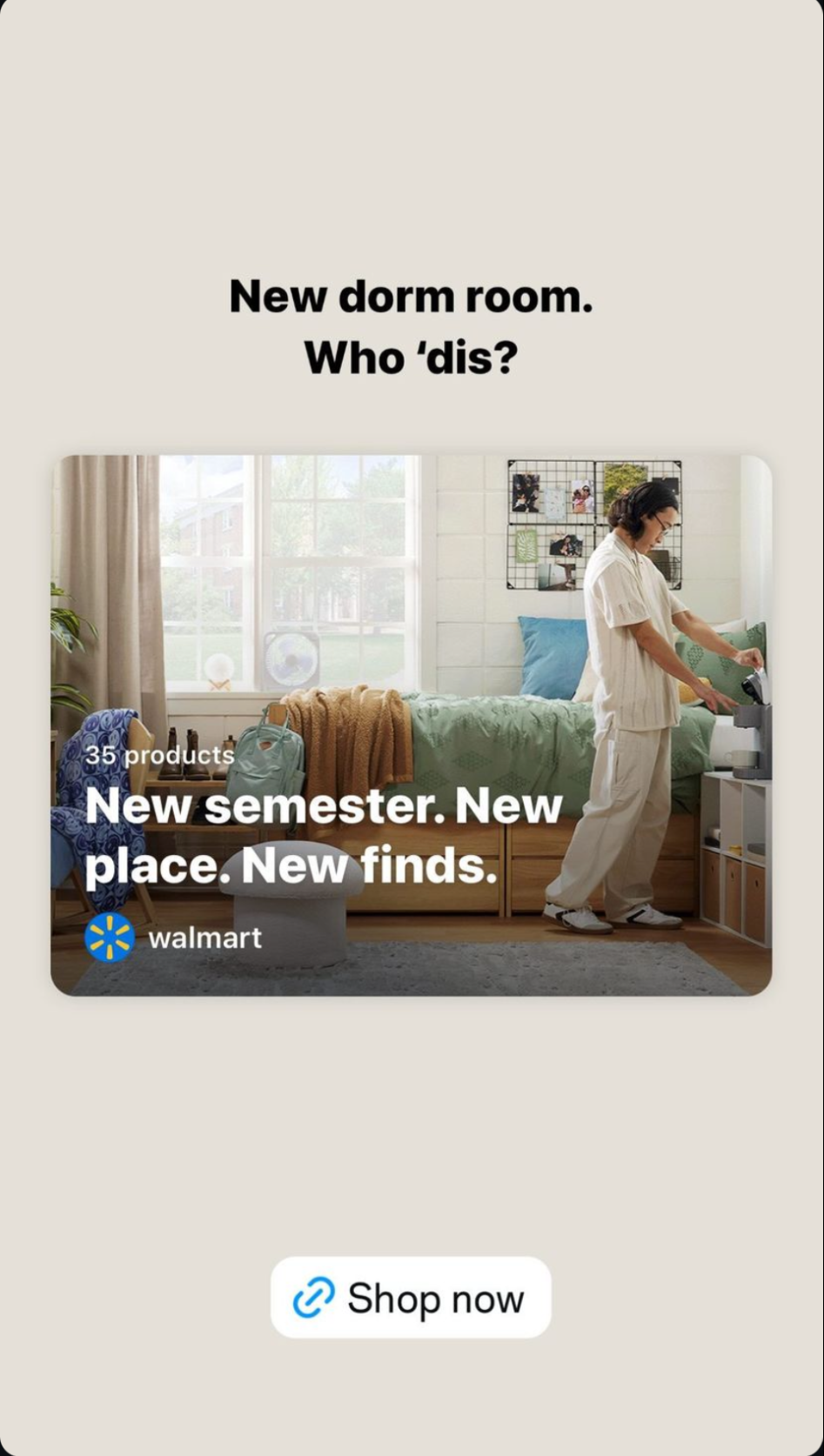
OnePlus does this perfectly with their “Shot on OnePlus” hashtag. Each month, they pick their favorite photo and feature it on their feed and stories:
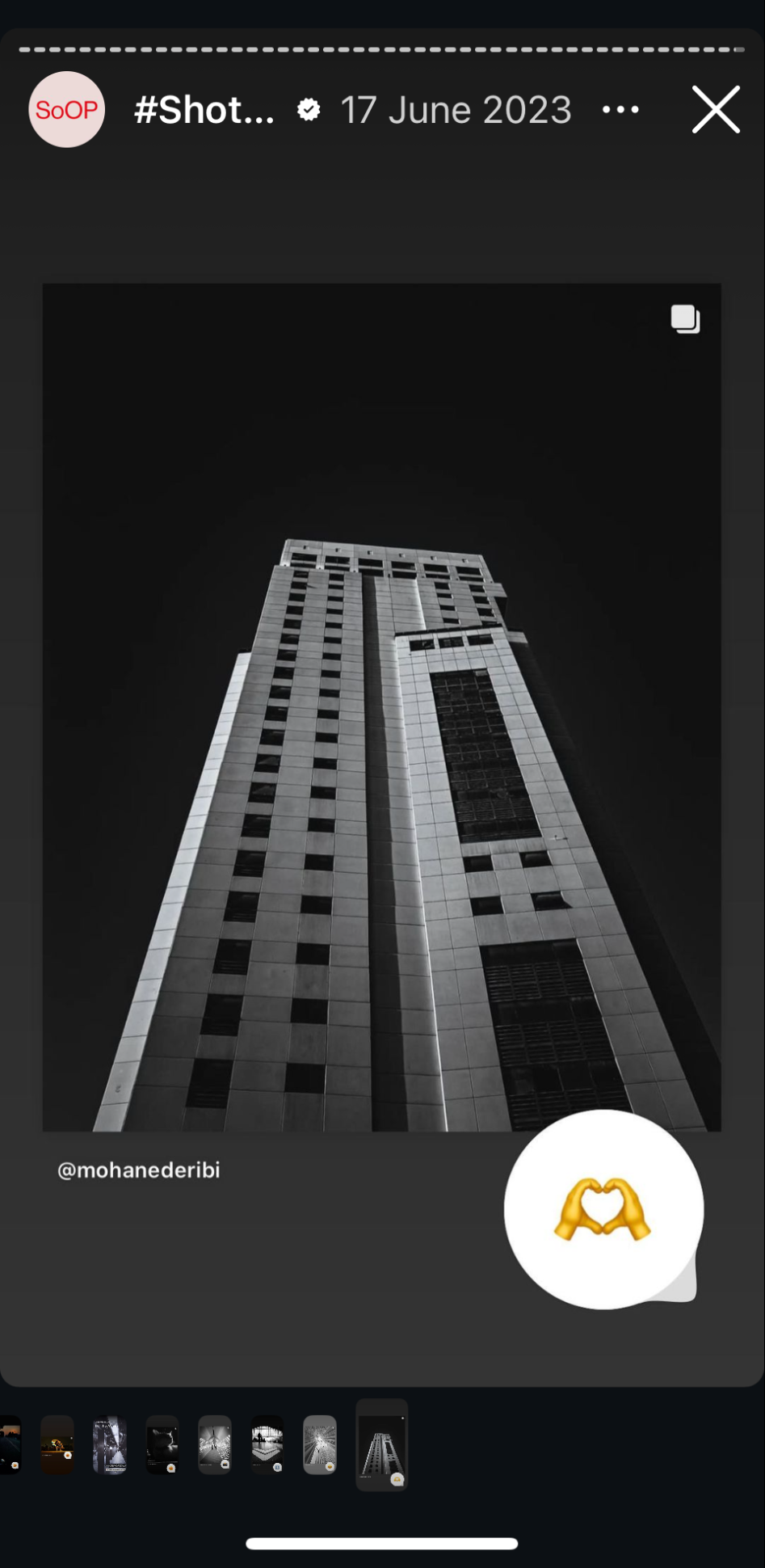
Personalization is a marketing technique that can turn any channel, campaign or content into an interactive experience. How? By tailoring it to their unique needs and preferences. Here are some personalized marketing strategies you can use:
Remember, personalization requires you to have the right type of customer data. You can gather this data through various methods, including sign-up forms, surveys and feedback, analytics, competitor research, interviews and focus groups.
One way to engage in a two-way dialogue with your customers is to implement conversational marketing tactics like live chat.
Kalyn Lewis, Head of Sales & Customer Experience at Visme says conversational marketing works because it taps into something simple but powerful: people want answers now, and they want them on their terms.
Head of Sales & Customer Experience at Visme
Here’s an example of Z bot—Zendesk’s AI assistant—that uses a list list of FAQs to drive the conversation:

Conversational marketing is particularly valuable for SaaS companies, where real-time product support can make or break a sale.
These real-time interactions help brands build stronger relationships with their customers, address concerns promptly and personalize the buying experience.
As Kalyn Lewis aptly puts it, every person and business is unique and interactions should reflect that uniqueness.
Head of Sales & Customer Experience at Visme
Experiential marketing is when brands step beyond the screen to create tangible customer experiences. Some examples of experiential marketing include setting up interactive installations or planning activations that bring brands to life in the physical world.
Another tactic is to use augmented reality (AR) and virtual reality (VR) technology to deliver memorable experiences. For example, NYX Cosmetics has a virtual try-on on their website that shoppers can use to see which products go well on their skin:

If you’re looking for inspiration, here’s a handpicked collection of interactive marketing examples in action from real-life brands.
We’ll talk about what each interactive marketing idea is, why it works and the best practices for applying it successfully to your business.
Talkdesk’s interactive report is an excellent example of how brands can turn traditionally static content into dynamic, interactive experiences.
Along with offering a PDF version of their research report, Talkdesk created a live, web version of their report with scroll-based animations, hotspots and interactive data visualizations.

Why It Works: The interactive elements of the report make it more engaging and easier to digest, which enhances user experience and retention. This approach also reflects the report’s main theme: the importance of interactivity in improving retail customer service.
Pro Tip: Use Visme to create interactive reports and ebooks easily. You can add clickable or hover-based hotspots, embed audio, videos, maps and forms, add interactive data widgets, add 3D animated characters, add a flipbook effect and more.
Galactic Fed is a creative agency that developed this highly interactive magazine using Visme. The document displays their range of services and work samples innovatively. For example, their video ads are showcased as video embeds instead of static screenshots.
Users can also flip through the pages by clicking on the arrows on the sides, transforming the reading process into an interactive experience. There’s also a clickable CTA at the end that enables interested readers to easily get in touch with the agency.
Why It Works: This digital magazine shows off Galactic Fed’s skills in a way that lets clients see and interact with their work. Letting readers flip pages and watch videos keeps them hooked and leaves a great impression. It's a smart way to prove they're creative while clearly showing what they offer.
Pro Tip: Use Visme to create an interactive digital magazine of your own. Pick a magazine template or booklet template, then spice it up with videos, animations, hotspots and buttons. Add a flipbook effect to create that satisfying page-flip feel. And don't forget a strong “Contact Us” button at the end to turn interested readers into potential clients.
Made with Visme Presentation Maker
This joint webinar from Visme and 5Mins is one of the best examples of interactive marketing in action. The webinar presentation is made with Visme and talks about how important visual communication is in training and education and how TikTok’s short-form video format plays a big role in engaging audiences.
The highly interactive presentation features elements like video embeds, mockups, 3D animated graphics, hover-based hotspots, links and an interactive radial chart. This is what makes Visme one of the best interactive presentation tools.
Why It Works: This presentation practices what it preaches. By using lots of interactive elements, it keeps viewers engaged and demonstrates the power of visual, interactive content marketing. It's not just telling you about effective communication—it’s showing you in real-time.
Pro Tip: When creating your own interactive presentation, mix different types of content to keep things interesting. Use Visme’s features like hover effects, embedded media and interactive charts to turn a standard slide deck into an engaging experience.
IKEA has embraced the trend of live shopping videos to bring their showroom experience directly to customers’ screens. These interactive livestreams showcase IKEA products in real-time, with hosts demonstrating how to use and style different items.
The videos often feature room setups or themed collections, like “Get ready for college” or “Sunny style, Miami vibes.” The best part is that viewers can interact with the video by liking or making purchases during the stream.
Why It Works: These live videos bridge the gap between online and in-store shopping. They offer the personal touch of an IKEA showroom visit, complete with expert advice while allowing customers to shop from home. The real-time interaction builds trust and helps customers make informed decisions.
Pro Tip: When planning your live shopping events, prepare a mix of scripted content and room for spontaneous interaction. Use tools that allow you to display product information and purchase links in real time. Practice with your team to ensure smooth transitions and be ready to troubleshoot technical issues on the fly.

Visme takes interactive conversational marketing to the next level with its live chat and fast email support features. As you browse the Visme website, you’re never more than a click away from getting help.
The live chat feature pops up discreetly on the page, inviting visitors to start a conversation. It’s staffed by knowledgeable team members who can provide real-time answers and guidance.
For those who prefer email, Visme promises quick responses to ensure no question goes unanswered for long.
Why It Works: This approach turns the browsing experience into a two-way conversation. It reduces friction in the customer journey by providing immediate answers, potentially boosting conversions. It also gives Visme valuable insights into customer needs and pain points in real time.
Pro Tip: When adding interactive support to your site, make it contextual. Use triggers based on user behavior—like time spent on a page or specific actions—to offer relevant help. Train your team to not just answer questions, but to guide users towards solutions that showcase your product’s value. And don’t forget to analyze chat logs and email queries to improve your product and marketing messaging.
DJI makes the most of its YouTube page by not just showcasing its products in action but also enabling viewers to make a purchase using the in-video shopping links.
This video is a prime example of this strategy. It features breathtaking aerial footage of Bali’s landscape which serves two purposes: entertaining viewers with stunning visuals and showcasing the impressive capabilities of the DJI Air 3 drone.
Why It Works: In-video shopping links eliminate barriers between inspiration and action. Viewers who are impressed by the drone’s performance can immediately explore purchasing options without leaving the platform, reducing the risk of losing potential customers in the transition from interest to purchase.
Pro Tip: While designing your interactive marketing content, strive for a balance between providing value to your audience and promoting your product. Make your in-video links less intrusive so viewers can enjoy great content regardless of purchase intent. This approach can lead to higher engagement rates and more organic sharing of your marketing content.
Next on our list of interactive marketing examples is Outgrow. They’ve transformed their landing page into an interactive showcase of their core offerings.
Instead of just describing their services, Outgrow lets visitors fill out a short survey and provides tailored suggestions for quizzes, calculators, chatbots, assessments and recommendations. This approach not only engages visitors but also gives them a taste of what Outgrow can do for their business.
Why It Works: With this interactive landing page, Outgrow flawlessly demonstrates its product’s value while providing immediate utility to visitors. This approach helps increase engagement, build trust and makes Outgrow’s value proposition tangible from the get-go.
Pro Tip: By allowing visitors to test drive your service, you’re not just telling them about your product—you’re letting them experience its benefits directly. This hands-on approach can be far more persuasive than traditional marketing tactics.
Monday.com elevates the concept of a product landing page by allowing visitors to create customizable workboards. All you have to do is select the main product category (work management, CRM and dev tools) and use case (creative & design, operations, marketing, etc.) and Monday.com will generate a unique workboard.
Why It Works: This interactive approach lets website visitors visualize how Monday.com can adapt to their unique workflows across various business functions. It also engages them more deeply than a traditional feature list would.
Pro Tip: When showcasing versatile products, consider creating an interactive demo on your landing page. This allows potential customers to explore your product’s adaptability firsthand, making its value immediately apparent.
Atlassian takes a unique approach to content marketing with a dedicated “Quizzes” section on its “Resources” page. In addition to the articles, guides and podcasts on workplace dynamics, they offer visitors a chance to test their knowledge and gain insights through fun, interactive quizzes.
Why It Works: While entertaining and educating the readers, quizzes are subtly used to highlight the workplace challenges Atlassian's products can solve. This encourages self-reflection and nudges them to explore potential solutions.
Pro Tip: Quizzes are excellent at not only boosting engagement but also providing valuable insights into your audience’s challenges and knowledge gaps. Use these findings to improve your product offerings and personalize your marketing messages.
Boohoo uses Instagram’s interactive story features to create an engaging shopping experience for its audience. They capitalize on the excitement surrounding the European Football Championship with the model in an “ENGLAND” t-shirt holding a Boohoo-branded football to create an immediate connection with fans.
They’ve also added an interactive “TAP TO SHOP” link to their story, allowing users to browse the discounted products.
Why It Works: Boohoo’s approach combines the power of event-based marketing with the convenience of direct shopping links. It uses the excitement surrounding the Euros and creates urgency by offering a limited-time discount.
Pro Tip: When using Instagram's link feature in Stories, make sure the landing page matches your story’s content and offer. And use clear call-to-actions like “Tap to Shop”, “Shop Here” or “Get Discount Here” to guide users on what to do next.
Implementing interactivity requires time and careful planning. Follow the steps below to create an interactive marketing strategy that truly resonates with your audience and drives maximum results for your business.
Before you start experimenting with different types of interactive content, ask yourself:
What do you want to achieve with your interactive marketing? More leads? Better engagement? Brand awareness? Your goals will shape the rest of your strategy so you can focus your resources where they have the most impact.
Use this SMART goals template from Visme to outline your goals:
Next, get to know your audience. How do they behave online? What type of interactive content do they like to engage with? Which channels do they use the most? Use tools like Google Analytics, social media analytics, interviews and surveys to gather this information.
Then, create audience personas to visualize who you're talking to.
Here’s a customer persona template from Visme that you can customize for this purpose:
Creating personas will help keep your team on the same page and help you focus your efforts where they matter. The better you understand your audience, the more effective your interactive content marketing efforts will be.
There are tons of interactive marketing tactics out there, but not all will work for you. Focus on those that fit your goals and what your audience likes based on the research you conducted in the previous step.
For example, if your goal is to generate leads and your audience enjoys problem-solving, maybe an interactive calculator is the way to go. For brand awareness with a visually oriented crowd, consider AR filters or interactive videos.
Make sure your chosen tactics also fit into your overall marketing strategy. Create a scoring system to rate each tactic based on how well it matches your goals, audience preferences and what you can realistically do.
This will help you pick the best options for your campaign. For example, use Visme’s decision matrix template to score ideas and narrow down your options:
Developing interactive assets is a time-consuming and often expensive process. It’s a good idea to have both an interactive marketing plan and content plan before you dive into the execution.
This will prevent any resource wastage, minimize errors and ensure everything runs smoothly.
Mahnoor Sheikh, a seasoned content strategist, advises marketers to always keep the user experience front and center when planning interactive content.
Experienced Content Strategist
Finalize the following key items when developing your interactive content plan:
Work with your team to brainstorm ideas and content specifics. You can use our whiteboard tool for this purpose. Create flows, sketches, wireframes and more together with your team.
Time to bring your ideas to life! Create content that's unique and valuable to your audience. Whether it's a quiz, an interactive video or an AR filter, make sure it serves a purpose.
Keep the design clean and user-friendly. Your audience should intuitively know how to interact with your content. For example, if you’re creating an interactive report, consider adding clues around hotspots like “Click Here” or an arrow/touch sign.
You can use Visme to create professional-looking interactive content, even if you're not a design pro. Easily add charts, maps, animations, links, hotspots, hover effects, multimedia, forms and a flipbook effect to your projects using built-in tools and a drag-and-drop interface.
Pro Tip: Need help with creating text or images? Use Visme’s AI Writer and AI Image Generator to quickly generate editable content based on prompts. You can also edit existing images or photos using our AI Image Editing tool, such as removing backgrounds.Before you launch, test your content thoroughly. Get feedback from a small group and make tweaks as needed. You can also internally set up approvals, deadlines and a feedback system using our workflow management tool.
Finally, work together with your team using our robust collaboration features. Comment, annotate and respond to feedback, and work simultaneously on projects to make them extra awesome.
Your content is ready—now it’s time to get it out there. Visme offers several ways to share your content while keeping things interactive:
Don’t forget to promote your interactive content across social media to make sure it gets the exposure and engagement it deserves. Design eye-catching social media graphics or short promo videos to grab attention.
For example, if you’ve created an interactive infographic for your blog, share a video or GIF about it on LinkedIn, Twitter or Instagram, showing off its functionality and how cool it looks. Add a link in the description or caption to drive more traffic.
Use Visme’s social media scheduler to plan your interactive or promotional posts in advance. Set them up to go live on specific times and dates and share directly through Visme.
Last but not least, track the performance of your interactive content. Use Visme's analytics to see metrics like views, engagement rates, and time spent on the page.
But dig deeper too. If you wanted to generate leads, how many did you get? For brand awareness, look at social shares and mentions. Use Google Analytics to understand how people are interacting with your content.
Review these numbers regularly and be ready to adjust your strategy. Maybe certain types of content are more popular, or specific topics get more engagement. Use what you learn to keep improving your interactive marketing strategy.
The effectiveness of interactive marketing lies in its ability to engage customers directly and personalize experiences in real-time. It creates two-way communication between brands and their audience which leads to higher engagement rates, improved customer satisfaction and increased conversion rates compared to traditional marketing methods.
The five common interactive media are social media platforms, interactive websites, mobile apps, gamified content and augmented reality experiences.
Interactive marketing tools include chatbots, quizzes, videos, social media polls and personalized email campaigns.
Interactive marketing revolves around the idea of creating two-way, personalized communication between brands and consumers, which eventually leads to more effective marketing outcomes and stronger customer relationships.
Marketers use interactive content to increase engagement, gather valuable user data, improve brand recall and deliver memorable experiences to their audience.
The joint webinar of Visme and 5Mins is one of the best examples of interactive marketing in action. It features multiple interactive elements, including embedded videos, mockups, 3D animated graphics, hover-based hotspots, and interactive radial charts to keep viewers engaged.
An interactive content strategy involves planning, creating and distributing engaging content that encourages active user participation. This includes interactive videos, infographics, quizzes and polls to achieve specific marketing goals.
Interactive marketing offers a range of benefits for your business, from higher engagement, ROI and loyalty to valuable data collection that can help you deliver personalized experiences.
A big part of your interactive marketing strategy is creating interactive content. Using the right tools to develop and distribute this content can be a game-changer for your brand. That’s where Visme comes in—an all-in-one content creation platform you can use to create highly engaging and interactive documents, presentations, infographics, charts, videos, lead forms and more.
Embed multimedia, links, hotspots, hover effects, 3D animated characters, motion effects and page-flipping effects to take your content to the next level. Better yet, streamline your design process using branding, collaboration, workflows and generative AI tools.
Ready to create interactive content like a pro? Sign up for a free account and level up your marketing strategy today with Visme.
Design visual brand experiences for your business whether you are a seasoned designer or a total novice.
Try Visme for free